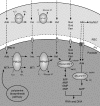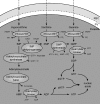Purine salvage pathways in the intraerythrocytic malaria parasite Plasmodium falciparum
- PMID: 18567789
- PMCID: PMC2519781
- DOI: 10.1128/EC.00159-08
Purine salvage pathways in the intraerythrocytic malaria parasite Plasmodium falciparum
Figures


References
-
- Asahi, H., T. Kanazawa, Y. Kajihara, K. Takahashi, and T. Takahashi. 1996. Hypoxanthine: a low molecular weight factor essential for growth of erythrocytic Plasmodium falciparum in a serum-free medium. Parasitology 11319-23. - PubMed
-
- Baldwin, S. A., G. A. McConkey, C. E. Cass, and J. D. Young. 2007. Nucleoside transport as a potential target for chemotherapy in malaria. Curr. Pharm. Des. 13569-580. - PubMed
-
- Bhat, J. Y., B. G. Shastri, and H. Balaram. 2008. Kinetic and biochemical characterization of Plasmodium falciparum GMP synthetase. Biochem. J. 409263-273. - PubMed
-
- Booden, T., and R. W. Hull. 1973. Nucleic acid precursor synthesis by Plasmodium lophurae parasitizing chicken erythrocytes. Exp. Parasitol. 34220-228. - PubMed
Publication types
MeSH terms
Substances
Grants and funding
LinkOut - more resources
Full Text Sources
Molecular Biology Databases

